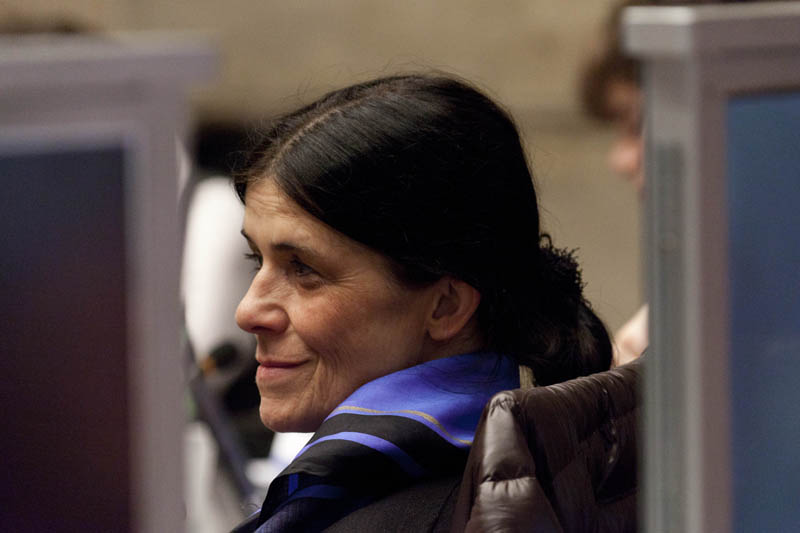
Member Profile: Anna Ursyn
1. What do you do, and how long have you been doing it?
I am an artist-teacher and I’ve been doing it as long as I remember.
2. What was your first job?
I was an assistant to the animation director of a short film when it meant a camera hanging above a table with many glass shelves. My role was to select different colors of paints for acetates placed on each shelf, so when the camera filmed through the shelves the effect of depth would be reached. Then I was matching the sounds with action by cutting fragments of strips from various rolls and then physically gluing them together.
3. Where did you complete your formal education?
I went through several programs to combine the power coming out of traditional media for two and three dimensional techniques with the precision and multi-presence of variables coming out of the computer, which outcome I saw as almost beyond our reach. I merged that with training in programming, statistical research, science and education in order to pursue my life–long interest in interdisciplinary education: how science inspires art and how art can grow out of science, math, and computing.
4. How did you first get involved with ACM SIGGRAPH?
I submitted my programmed artwork in 1988, just to find out that it was a year for an interactive art only.
5. What is your favorite memory of a SIGGRAPH conference?
My friend keeps saying that I go to SIGGRAPH for my annual energy shot.
6. Describe a project that you would like to share with the ACM SIGGRAPH community.
In 2002 I created a History of Computer Graphics and Art project at the Birds of a Feather session at SIGGRAPH. The History of Computer Graphics and Digital Art Project collects essays and images from artists, scientists, art historians, people shaping the museum and gallery display and those who influenced these disciplines, which reflects the unfolding of computer art due to technical achievements (hardware, software, languages, etc.).
More information about the project can be found in aJournal of New Media and Culture Article. This project is linked toTerrence Masson’s new book CG 101.
To submit work to the project, please view thecall for participation: http://education.www.siggraph.org/resources/history
It can be found on the SIGGRAPH’S server:http://education.www.siggraph.org/resources/cgsource/instructional-materials/history/
I am still hoping to see a constantly updated online database for researchers and teachers willing to teach on the subject.
7. If you could have dinner with one living or non-living person, who would it be and why?
For me a question would be to name people to work with if we’d be given some Home Depot Store with all the tools plus art materials, and technologies added for a project to collaborate on, then to develop a curriculum for new courses or even a program.
8. What is something most people don’t know about you?
My interest in art science integration came out of the most practical situations. When I was ten years old my parents sent me for an inland water sailing camp, followed by a practical and theoretical exams. I was getting through lots of practice, other exams, followed by my teaching, all requiring understanding of physical laws and forces combined with knowledge in areas decisive for survival at the sea. After enough sea sailing and teaching experience I was selected as one of the crew member for the Operation Sail (Tall Ships), where all the knowledge practiced and learned was combined with a teamwork to get us finish 13th in our category.
9. From which individual have you learned the most in your life? What did they teach you?
One of my professors, Carl Niederer was open to programming for the arts with elegance and fun in mind. He convinced the department to get me an ATM dumb terminal from a local hospital, so I could send my files for printing as black and white plots or slides with color, over the phone-based modem. My decision to work for the University of Northern Colorado was to a great degree inspired by the fact that Gene Hoffman was running Graphic Design area there. I knew his work since I was little from poster biennials we visited. It was a privilege working with a great artist and designer, a winner of seven Golden Pigs at the Society of Illustrators in NYC when developing my Computer Graphics area at the UNC.
10. Is there someone in particular who has influenced your decision to work with ACM SIGGRAPH?
Carl Niederer told me about it, encouraged to submit my work and even shown me how to make a box to deliver my work in for the SIGGRAPH’S Art Gallery when I had my artwork accepted in 1989, and then after.
11. What can you point to in your career as your proudest moment?
My proudest moment is when I produce art and am satisfied with some artwork in each production cycle, and when my students do the same, and do not quit their own art making after graduation.
Web site:ursyn.com